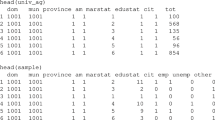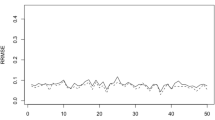Abstract
National statistical agencies are regularly required to produce estimates about various subpopulations, formed by demographic and/or geographic classifications, based on a limited number of samples. Traditional direct estimates computed using only sampled data from individual subpopulations are usually unreliable due to small sample sizes. Subpopulations with small samples are termed small areas or small domains. To improve on the less reliable direct estimates, model-based estimates, which borrow information from suitable auxiliary variables, have been extensively proposed in the literature. However, standard model-based estimates rely on the normality assumptions of the error terms. In this research we propose a hierarchical Bayesian (HB) method for the unit-level nested error regression model based on a normal mixture for the unit-level error distribution. Our method proposed here is applicable to model cases with unit-level error outliers as well as cases where each small area population is comprised of two subgroups, neither of which can be treated as an outlier. Our proposed method is more robust than the normality based standard HB method (Datta and Ghosh, Annals Stat. 19, 1748–1770, 1991) to handle outliers or multiple subgroups in the population. Our proposal assumes two subgroups and the two-component mixture model that has been recently proposed by Chakraborty et al. (Int. Stat. Rev. 87, 158–176, 2019) to address outliers. To implement our proposal we use a uniform prior for the regression parameters, random effects variance parameter, and the mixing proportion, and we use a partially proper non-informative prior distribution for the two unit-level error variance components in the mixture. We apply our method to two examples to predict summary characteristics of farm products at the small area level. One of the examples is prediction of twelve county-level crop areas cultivated for corn in some Iowa counties. The other example involves total cash associated in farm operations in twenty-seven farming regions in Australia. We compare predictions of small area characteristics based on the proposed method with those obtained by applying the Datta and Ghosh (Annals Stat. 19, 1748–1770, 1991) and the Chakraborty et al. (Int. Stat. Rev. 87, 158–176, 2019) HB methods. Our simulation study comparing these three Bayesian methods, when the unit-level error distribution is normal, or t, or two-component normal mixture, showed the superiority of our proposed method, measured by prediction mean squared error, coverage probabilities and lengths of credible intervals for the small area means.





Similar content being viewed by others
References
Battese, G. E., Harter, R. M. and Fuller, W. A. (1988). An error component model for prediction of county crop areas using survey and satellite data. J. Am. Stat. Assoc. 83, 28–36.
Chakraborty, A., Datta, G. S. and Mandal, A. (2019). Robust Hierarchical Bayes Small Area Estimation for Nested Error Regression Model. Int. Stat. Rev. 87, 158–176.
Chambers, R. L. (1986). Outlier robust finite population estimation. J. Am. Stat. Assoc. 81, 1063–1069.
Chambers, R. L., Chandra, H., Salvati, N. and Tzavidis, N. (2014). Outlier robust smallarea estimation. Journal of the Royal Statistical Society Series B 76, 47–69.
Chambers, R. L., Chandra, H. and Tzavidis, N. (2011). On bias-robust mean squared error estimation for pseudo-linear small area estimators. Survey Methodology 37, 153–170.
Datta, G. and Ghosh, M. (1991). Bayesian prediction in linear models: Applications to small area estimation. Annals Stat. 19, 1748–1770.
Datta, G. S. and Lahiri, P. (2000). A unified measure of uncertainty of estimated best linear unbiased predictors in small area estimation problems. Stat. Sin. 10, 613–627.
Efron, B. and Morris, C. (1973). Stein’s Estimation Rule and Its Competitors − An Empirical Bayes Approach. J. Am. Stat. Assoc. 68, 117–130.
Fay, R. E. and Herriot, R. A. (1979). Estimates of income for small places: an application of James-Stein procedures to census data. J. Am. Stat. Assoc. 74, 269–277.
Prasad, N. G. N. and Rao, J. N. K. (1990). On the estimation of mean square error of small area predictors. J. Am. Stat. Assoc. 85, 163–171.
Sinha, S. K. and Rao, J. N. K. (2009). Robust small area estimation. Can. J. Stat. 37, 381–399.
Stein, C. (1955). Inadmissibility of the Usual Estimator for the Mean of a Multivariate Normal Distribution, Proccedings of the Third Berkeley Symposium. University of California Press 1, 197–206.
Acknowledgment
The authors are thankful to Dr. Ray Chambers for providing the dataset used in Section 4.2. They also thank the editor for his supportive suggestions.
Author information
Authors and Affiliations
Corresponding author
Additional information
Publisher’s Note
Springer Nature remains neutral with regard to jurisdictional claims in published maps and institutional affiliations.
Electronic supplementary material
Below is the link to the electronic supplementary material.
Appendix: A
Appendix: A
1.1 A Integrability of Joint Posterior Probability Density Function
Chakraborty et al. (2019) showed that the joint posterior density function of \(\boldsymbol {\beta }, {\sigma ^{2}_{1}}, {\sigma ^{2}_{2}}, p_{e},\) and \({\sigma _{v}^{2}}\) is proper. In particular, they showed that the function
is integrable with respect to \(\boldsymbol {\beta }, {\sigma ^{2}_{1}}, {\sigma ^{2}_{2}}, p_{e},\) and \({\sigma _{v}^{2}}\), where \(L(\boldsymbol {\beta }, {\sigma ^{2}_{1}}, {\sigma ^{2}_{2}}, p_{e},{\sigma _{v}^{2}})\) is the likelihood function based on the distribution yij,j = 1,…,ni,i = 1,…,m obtained as the marginal distribution from (I)−(III) in Section 2. Similar arguments show that \(L(\boldsymbol {\beta }, {\sigma ^{2}_{1}}, {\sigma ^{2}_{2}}, p_{e},{\sigma _{v}^{2}})\frac {I_{\{{\sigma _{1}^{2}}{\geq \sigma _{2}^{2}}\}}}{({\sigma _{1}^{2}})^{2}}\) is also integrable with respect to the same variables. Now we note that
This implies,
The LHS of Eq. A.2 is bounded above by two integrable functions, hence it is also integrable.
1.2 A.2 Simulation Results with no Contamination of Unit-Level Errors
Rights and permissions
About this article
Cite this article
Goyal, S., Datta, G.S. & Mandal, A. A Hierarchical Bayes Unit-Level Small Area Estimation Model for Normal Mixture Populations. Sankhya B 83, 215–241 (2021). https://doi.org/10.1007/s13571-019-00216-8
Received:
Published:
Issue Date:
DOI: https://doi.org/10.1007/s13571-019-00216-8
Keywords and phrases.
- Nested error regression
- Outliers
- Prediction intervals and uncertainty
- Robust empirical best linear unbiased prediction





